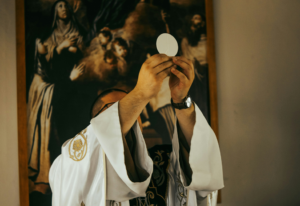The Alarming Statistics Facing Catholic Church Leaders: A Call for Eucharistic Revival
The Catholic Church in the U.S. faces a significant decline in membership, with 300,000 to 350,000 people leaving annually, while only 30,000 to 60,000 joining through conversions or adult baptisms. That means for every 1 or 2 adults entering, around 10 to 12 are departing. This trend reflects a deeper crisis of faith, particularly among younger generations who feel disconnected from Church teachings and spiritually unfulfilled. Additionally, only 17% of Catholics attend Mass weekly, and belief in the Real Presence of Christ in the Eucharist is waning, with many viewing the Church as irrelevant to their lives. These challenges emphasize the urgent need for Eucharistic Revival, which aims to reawaken faith at the parish level and rekindle devotion to the Eucharist, the very heart of Catholic life.
Current State of the Catholic Church in the U.S.
As of 2023, the Catholic population in the United States stands at approximately 61 million. This number, however, is juxtaposed with a troubling statistic: only 17% of U.S. Catholics attend Mass weekly, and an additional 18% participate at least once a month. This results in about 35% of U.S. Catholics attending Mass at least monthly. The decline in attendance has been accentuated by the lingering effects of the COVID-19 pandemic, which has reshaped religious practices across the country. For instance, many Catholics have grown accustomed to virtual participation in religious services, leading to a diminished sense of community and commitment to regular Mass attendance.
Belief in the Real Presence
A significant aspect of Catholic faith is the belief in the Real Presence of Jesus in the Eucharist. According to a study by the Center for Applied Research in the Apostolate (CARA), approximately 64% of Catholics affirm this doctrine. This belief is closely tied to Mass attendance: 95% of weekly attendees and 80% of those attending monthly accept this teaching. Conversely, a 2019 Pew Research survey revealed that only about 30% of Catholics believe in the Real Presence. The discrepancies in these findings can be attributed to differences in the demographics surveyed, yet both studies underscore a concerning trend regarding Eucharistic belief among Catholics.
A deeper analysis reveals that about 31% of Catholics truly believe in the Real Presence when considering attendance patterns. This figure arises from calculating 80% of the 18% of monthly attendees plus 95% of the 17% who attend weekly. Such statistics highlight the critical need for initiatives like the National Eucharistic Revival, aimed at rekindling a deeper understanding and commitment to the Eucharist among U.S. Catholics.
Declining Membership and Urgent Need for Revival
The trends within the Church paint a troubling picture. Approximately 30% of U.S. adults identify as religiously unaffiliated, commonly referred to as “nones.” This demographic includes roughly 96 million individuals, with around 23 million being former Catholics. Over the past decade, an estimated 300,000 to 350,000 Catholics leave the Church each year, amounting to about 6.5 million departures during this period.
When considering the relationship between those entering and leaving the Church, the figures are striking: for every one or two adults entering the Catholic Church—approximately 30,000 to 60,000 new members annually through conversions and adult baptisms—around 10 to 12 are departing. This stark imbalance illustrates the urgent need for revitalization within the Church.
Although the Church gains new members each year, primarily through conversions, this influx pales in comparison to the number of individuals leaving, emphasizing a concerning trend that demands immediate action and renewed efforts in evangelization and catechesis.
The Impact of Youth Disaffiliation
Perhaps most troubling is the statistic indicating that about 50% of young adults raised Catholic no longer identify with the faith by the time they reach adulthood. A 2018 Pew Research survey revealed that 36% of U.S. adults raised Catholic have distanced themselves from the Church, with many doing so during their late teens and twenties. Contributing factors include a disconnect between personal beliefs and Church teachings, lack of engagement with the faith community, cultural influences favoring secularism, and disillusionment stemming from scandals within the Church.
Young people often cite a lack of relevance in Church teachings and a perception that their voices are not heard as reasons for their disconnection. According to a 2019 report by the National Study of Youth and Religion, many young Catholics feel that the Church fails to address their concerns and needs. This disillusionment poses a significant challenge, as engaging youth in meaningful ways is crucial for the future of the Church.
Importance of Eucharistic Revival at Parish Level
To address these pressing issues, the National Eucharistic Revival seeks to rekindle a profound appreciation for the Eucharist, fostering a culture where belief in the Real Presence is both understood and embraced. By engaging lapsed Catholics and those on the periphery of faith, the Church can work toward reversing current trends and nurturing a vibrant spiritual life.
Local parishes play a vital role in this revival. They serve as the primary points of contact for most Catholics and can become centers of evangelization and formation. Revitalizing the Eucharistic experience at the parish level involves several strategies:
- Enhanced Catechesis: Parishes can implement robust catechetical programs focused on the Eucharist, emphasizing its significance in Catholic life. By providing educational resources, workshops, and interactive sessions, parishes can help parishioners develop a deeper understanding of the Eucharist and its implications for their spiritual lives.
- Community Engagement: Building a strong sense of community is essential for retaining members and fostering a vibrant faith life. Parishes can organize social events, service projects, and outreach programs to engage parishioners and foster relationships among members. A sense of belonging can encourage individuals to deepen their commitment to the Church.
- Liturgical Renewal: The celebration of the Eucharist itself can be revitalized to enhance participants’ experience. This includes focusing on the beauty of liturgy, incorporating music and art that elevate the worship experience, and ensuring that homilies are relevant and engaging. Effective preaching on the Eucharist can inspire attendees to appreciate its transformative power.
- Adoration and Prayer: Establishing opportunities for Eucharistic adoration can deepen parishioners’ connection to Christ in the Eucharist. Providing regular adoration hours, prayer groups, and retreats centered on the Eucharist can help individuals encounter Christ more profoundly.
- Involvement of Young Adults: Encouraging young adults to take active roles within the parish can create a sense of ownership and involvement in the Church’s mission. Providing leadership opportunities, such as youth ministry, music ministry, or service projects, can engage this demographic and help bridge the gap between the Church and younger generations.
- Outreach to Lapsed Catholics: Parishes must actively reach out to lapsed Catholics, inviting them back into the fold with compassion and understanding. Initiatives like the “Invite One Back” campaign can encourage parishioners to personally invite friends and family members who have drifted away from the faith to return to the Church.
Addressing the Root Causes
To reverse the trend of declining participation and belief, it is crucial to address the root causes of disaffiliation. Many Catholics leave the Church due to perceived hypocrisy, lack of engagement, or failure to address contemporary issues. By creating an open and welcoming environment, Church leaders can demonstrate a commitment to living out the Gospel in tangible ways.
Parishes can also provide forums for dialogue on difficult issues, allowing parishioners to express their concerns and feel heard. Engaging with social justice issues, mental health awareness, and community service can make the Church more relevant to contemporary society, fostering a sense of connection and mission among parishioners.
Conclusion
In conclusion, the alarming statistics surrounding Catholic attendance and belief in the Eucharist highlight a critical juncture for Catholic leaders and the faithful. The declining attendance and belief in the Eucharist signal an urgent need for renewal and revitalization, especially within local parishes. The ongoing efforts of the National Eucharistic Revival are vital in rekindling faith, fostering community engagement, and deepening the understanding of the Eucharist, which is central to Catholic identity.
By implementing strategies that focus on catechesis, community engagement, liturgical renewal, and outreach, local parishes can play a pivotal role in reversing these trends. The Church must act decisively to address the root causes of disaffiliation and create a vibrant, welcoming environment that fosters a deep love for Christ in the Eucharist. Through these efforts, the Church can work toward a future where the faithful are renewed in their commitment to the Eucharist and its transformative power in their lives.
Reflection Questions
- How can my parish inspire a deeper devotion to the Eucharist among all age groups?
- In what ways can we better engage younger generations in the life of the Church?
- How can we rebuild trust and belief in the Real Presence of Christ in the Eucharist?
References
- Pew Research Center. “The Future of World Religions: Population Growth Projections, 2010-2050.”
- CARA. “Catholics and the Eucharist: Results of a National Study.”
- Pew Research Center. “The Catholic Church and the LGBTQ Community.”
- Pew Research Center. “The U.S. Religious Landscape Survey.”
- CARA. “Understanding the Faith and Practice of U.S. Catholics.”
- Pew Research Center. “The Decline of Religious Affiliation.”
- Pew Research Center. “The Rise of the Nones.”
- CARA. “The Catholic Church in the United States.”
- Pew Research Center. “The Decline of Catholicism in America.”
- Pew Research Center. “The Future of Religion in America.”
- Pew Research Center. “Millennials and Religion.”
- Pew Research Center. “Young Adults and the Catholic Church.”
- National Study of Youth and Religion. “The Disaffiliation of Young Catholics: Causes and Consequences.”






